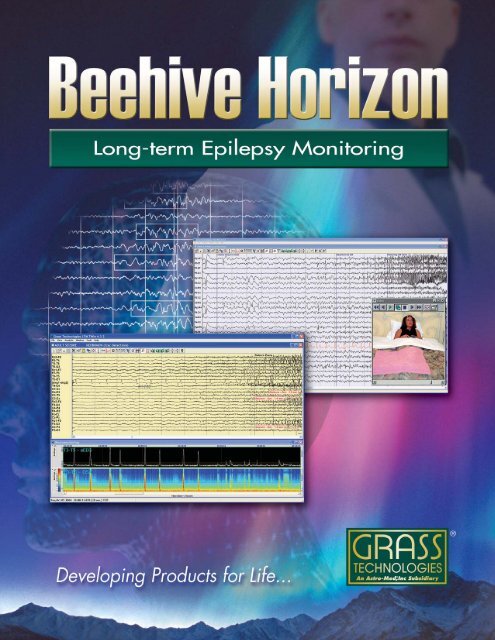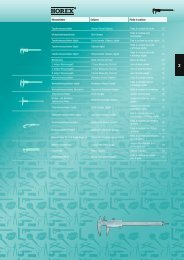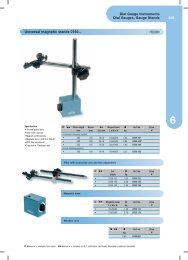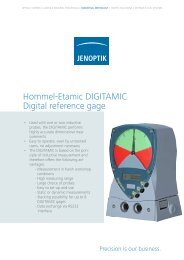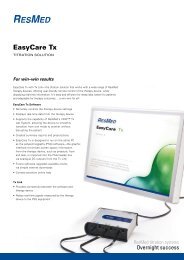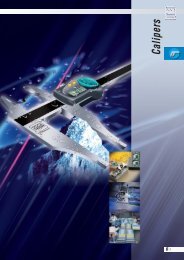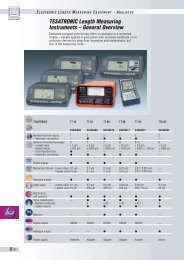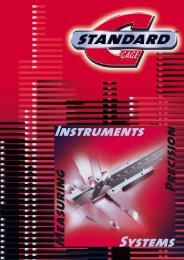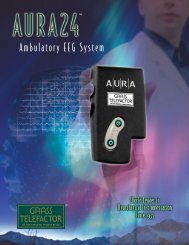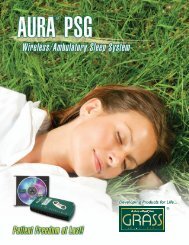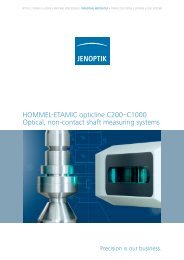Amplifier Systems - Teknikel
Amplifier Systems - Teknikel
Amplifier Systems - Teknikel
- No tags were found...
Create successful ePaper yourself
Turn your PDF publications into a flip-book with our unique Google optimized e-Paper software.
Powerful Instrumentsfor Long-ter m MonitoringThe Beehive Horizon is the next generation of recorders in theubiquitous Beehive Long-term Monitoring product line. Decadesof experience in designing and manufacturing reliable, highqualityepilepsy monitoring instrumentation combined with thelatest technology has produced a powerful Windows-baseddigital EEG/Video instrument with complete data acquisition,recording and review capabilities that are specialized forepilepsy monitoring applications.SUPPORT & SERVICEAll Grass Technologies instrumentation is backed by aknowledgeable support staff ready to respond to all of yourneeds. Technical support is available 24 hours a day, 7 days aweek. On-line, web based remote assistance allows our supportstaff to work on your system directly for quick resolution of mostissues. User training is provided on-site, and free courses at ourcompany headquarters are available for additional staff training.FEATURES:• Compact patient worn amplifiers design to be rugged,lightweight, and ease to use• Modular 32, 64, 128 channel amplifiers• Highest quality EEG amplifiers with unsurpassed traceclarity• High Resolution, high quality digital video and audiorecordings• On-Line proven SzAC seizure and spike analysis software• Intuitive review timeline for fast navigation and editing ofLTM recordings• Real-time video/EEG monitoring over the network• Built-in Panorama digital video with highly-efficient GrassTechnologies MPEG4 compression for 640 x 480 NTSC(768 x 576 PAL) resolution• Limited Lifetime Warranty on Grass Technologiesmanufactured parts (see our full warranty for details)Compact 42-channel system featuresbattery for Patient mobility:42-Channel System:• 32-channel AURA <strong>Amplifier</strong>• 8-input DC Module• Pulse Oximeter for SaO2 and Pulse Rate• Patient Event pushbutton• Photic Control64 to 128-channel system for intensivemonitoring with high sampling rates:64/128-Channel System:• AURA-LTM64 <strong>Amplifier</strong>• High Sampling Rate up to 3200 samples/second• High Frequency Response up to 1000 Hz• Patient Event pushbutton• Photic Control2
<strong>Amplifier</strong> <strong>Systems</strong>Grass Technologies amplifiers are world-renowned in the field of neurophysiology for their quality, reliability, simplicity, and serviceability. Theamplifier system provides isolation, amplification, filtering, and digitization. Communication with the host computer is via a standard Ethernetcable to the PC’s network interface card. TWin software sets the sample rate, starts and stops Video/EEG acquisition, and stores the data tothe PC’s hard disk or fileserver.AURA® 42-CHANNEL AMPLIFIER SYSTEMAURA (Ambulatory Universal Recording<strong>Amplifier</strong>) amplifier system has a frontendsampling rate of 400 Hz (record200 or 400 Hz, user definable). Theelectrode input jack box provides 32 ACinputs, 2 reference inputs and 2 groundinputs. The redundant references andgrounds provide reliability and signalintegrity during long-term monitoringprocedures.The 42-channel system has the capability ofrecording data directly to a PC or can be untethered for temporaryambulatory recordings. The compact and lightweight design of AURAoffers maximum patient comfort, without sacrificing the ruggednessrequired for long-term studies.AURA is typically tethered to the base station, which streams data toa host computer running TWin. However, AURA is also capable ofoperating untethered. When the patient cable is disconnected, AURAwill automatically switch and record the EEG data to a CompactFlash(CF) memory card. If there is an immediate need to download andreview the data stored on the CompactFlash memory card, the CFcan be removed from AURA and the data can be downloaded quicklyvia a USB CompactFlash Reader.With AURA, the patient can move from their patient room to a dayroom. When the patient arrives at the day room, AURA simply needsto be plugged into any base station located in that room. Our TWinrecording software will recognize that the patient has switched to anew base station, and tethered recording will resume. An automaticroom switching option is available to also switch the video and audiofrom the patient room to a dayroom.An 8-channel DC input module and optional pulse oximeter(SpO2/HR) allow for an additional 10 channels of data. This flexibilityallows for a wide range of physiological parameters to be monitoredand recorded. An optional external battery pack is available to enablerecording of 24-hour ambulatory EEG studies. The technologist cancheck electrode impedances, perform amplifier calibration, andcontrol the photic from the Base Station.AURA-LTM64 64 & 128-CHANNEL AMPLIFIER SYSTEMThe AURA-LTM64 amplifier, with highsampling rate up to 3200samples/second and integratedelectrode input connections, isdesigned for use either as abedside amplifier or as awearable cabled-telemetryamplifier unit which allowsthe patient to have greaterfreedom of movementwithin their patient room.Provided accessoriesinclude a patient-wornpouch and 33-foot (10 m)patient cable. Theintegrated electrode inputconnections provides 64 ACinputs, 2 reference electrode inputs, and 2ground inputs. Two amplifiers are connected for 128-channelrecordings using a single link cable between them. Jack box labelsare provided for labeling the inputs with international 10-20 and 1-64 numerical nomenclature, 10-10 nomenclature, and/or 65-128nomenclature. The AURA-LTM64 64/128 amplifiers are modular andcan be used with multiple recording systems.When used for scalp recording, the amplifiers built-in electrodeimpedance meter can be activated via software from the recordingPC, or by pressing the impedance button on the amplifier. Theelectrode connector inputs exceeding the user-defined impedancevalue will light up, making it easy for the technologists to identifywhich electrodes need attention. When used for invasive electroderecordings, the built-in impedance meter is disabled.AURA-LTM64 amplifier system’s maximum possible sample rate is3200 samples per second (64 channels) with a maximum possiblebandwidth up to 1000 Hz*. Auxiliary inputs are also available forconnecting a Patient Event pushbutton and an optional photicstimulator.* The sampling rate and the storage rate is set by TWin software and available samplingrates are dependent on the TWin software version.3
TWin® LTMFlexible, , easy-to-use softwarareTWin LTM is the powerful software that runs the Beehive Horizonsystem. Many years of dedication to the field of neurodiagnostics hasallowed Grass Technologies to develop a software platform that is easyto use, yet flexible enough to expand upon. TWin LTM software isused both for recording and review. All software modules of TWinLTM are produced by Grass Technologies, resulting in full integrationand ease of use.Flexibility: TWin LTM will meet your specific needs, requirementsand preferences. Easy to use tools allow the user to customizenotation lists, montages, event definitions, keyboard triggers, photicstimulation sequences, waveform display views and more.Montages: Create virtuallyunlimited montages, off-lineor in real-time, with theintuitive Montage Editor. TheMontage Editor uses agraphical head-stampinterface for programmingscalp montages, plus anInvasive Electrode montagecreator which willautomatically name theelectrodes, create referentialoutput montages, and createbipolar output montages byRow or Column. User-defined average-reference montages, channeltypes, and trace colors can also be defined. The Montages used for agiven study are also stored with the EEG data for retrieval duringreview or in the future when reviewing archived data.direct links to programs in Microsoft Office ® for report generation anddatabase management. TWin can also import EDF files.Patient & Study DatabaseTWin’s Database Explorer allows efficient manage of patients andstudies. Fully integrated with TWin acquisition/review/report softwareand Patient Scheduler, the Database Explorer allows the user to:• Launch TWin Acquisition and Review• Search, sort, and query patient and study information• Add user-definable fields which can be queried• Define and save frequently used queries• Link to, and easily access other files (Word, Reports, images, etc.)• Quickly archive study data to CD/DVD/USB Drives• Track patient progress• Track activity of laboratory staff and referring physiciansThis HIPAA compliant software is password protected, allowsmultiple users and log-ins, allows user access levels to restrictfeatures, and tracks user activity.User Profiles: Use Profile Manager to configure a profile for eachtechnician or doctor using the system. Their montage, trace color,record configuration, review setup, and other preferences are storedand loaded at any time. Specific test applications and parameters canalso be saved as different profiles.Recorder: The EEG, Video, and SzAC spike and seizure recordingmodules open with just a double-click on the TWin “Start Recording”icon. Easily perform impedance checks, calibrations, and montageadjustments. Entering user-defined events and annotations is assimple as a single keystroke. Accurate, high-quality digital recording isguaranteed.Reviewer: Easily bring up a patient study for quick review withTWin’s intuitive Database Explorer. Utilize keyboard or on-screencontrols to navigate through a record. Amplitude and measurementtools, along with zoom capabilities allow the user to accurately analyzespecific waveforms. Potential Mapping and Spectral Analysis tools areincluded with TWin for advanced data review.TWin export functions allow output of information (raw data, graphics,and text to standard formats (including ASCII and EDF), as well asRemote Video/EEG ReviewTWin LTM software is Citrix compatible. Having TWin LTM installedon the lab’s or hospital’s Citrix Server allows multiple andsimultaneous users to review video and EEG data from virtuallyanywhere in the world from any PC with Internet access.4
TWinLOOK ® Review Software• Review patient data anywhere• Friendly, easy-to-use interface• Ideal for sharing data with colleagues• Compatible with Microsoft PowerPoint ®With the TWinLOOK review-only software, Video/EEG, EEG, or PSGrecordings can be reviewed on any Windows ® XP/Vista ® computer,without the need to purchase additional software. TWinLOOK offers afriendly interface that allows the user to review studies recorded onany TWin-based acquisition system. The user can change montagesand adjust filter and amplitude settings, review synchronized video,view annotations and reports.Panorama ® Digital Video & Audio Software• Grass Technologies MPEG4 video compression for 640x480 NTSC(768x576 PAL) high resolution video with ultra low data rates• Full window resizing during acquisition & review• Overlay: up to full screen digital video display with waveform dataappearing over the video image with transparent background• Virtual Pan & Zoom features during acquisition & review• Digital brightness, contrast and color saturation controls duringrecord and reviewTWinLOOK can be incorporated into PowerPoint slide shows forpresenting video/EEG samples. Video and EEG will automatically startand stop playing based upon user editing.TWinLOOK also allows physicians and hospital to send data acquired intheir laboratory to others for review, facilitating exchange of data withreferring physicians, colleagues, collaborators, and/or to obtain secondopinions.SzAC ® Seizure & Spike Analysis SoftwareSzAC is an on-line seizure and spike analysis software package.SzAC’s utility is proven to reduce review time of long-term EEGrecordings, allowing the person reading the study to quickly viewevents of interest without having to page through the entire recording.SzAC was the first commercially available seizure and spike detectionprogram. It has continued to evolve and improve through GrassTechnologies’ ongoing research and development. The defaultdetection parameters are optimized for minimal false positive andfalse negative results, however the user can adjust parameters asneeded.During review, the SzAC review timeline graph allows a 24-hourrecording to be viewed at a glance. Marks indicate patient pushbuttonevents and automatic detections. Clicking on these marks will bringup the corresponding page of EEG for visual confirmation of the event.Quickly jump from one event to the next.The SzAC Timeline is also used for pruning and editing recordings andfor marking video and EEG events of interest for saving and archiving.The Panorama Digital Video Recorder uses the latest Grass MPEG4-based video compression. Grass digital video compression permitsthe highest resolution with the lowest storage needs. Thecompression techniques are optimized for smooth networkfunctionality and it uses a self-adjusting variable data ratedepending on the amount of motion in the picture, whilemaintaining the same level of quality. Lower data rates requirelower disk storage space and result in faster data transfer.The Overlay feature, unique to Grass Technologies, allows displayof the video image behind the waveforms with a transparentbackground. This allows you to see both the patient image and allof the waveform traces. Video and EEG can be viewed in real-timefrom remote locations (Nurses’ station, physician’s offices, etc.)over the network. A complete line of portable or wall/ceilingmounted cameras, infrared illuminators, audio systems andmonitors are available.Optional Software e Add-onsd-onsRequest more information on the following TWin Softwarepackages:• NeuroTrac III Neuromonitoring Software for amplitude,frequency and burst-suppression trending• Patient Scheduler Software integrated with the TWin Databasefor complete lab management• TWin Monitor2 Software for remote video/EEG real-timeviewing and system control• TWin Portal Software for HL7 interface to the HospitalInformation System5
Options & AccessoriesNURSE STATION ALARMThe Nurse Station Alarm (NSA) is an optional accessory foracquisition systems typically used in a Long-term SeizureMonitoring environment. The purpose of NSA is to alert staff ofpatient conditions associated with seizure monitoringprocedures:• Patient Pushbutton Events• Seizure Detections made by SzAC software• Patient Cable DisconnectsThe NSA is a multi-bed system which allows a single station tocommunicate with multiple recording systems over the network.The communication between the NSA and the acquisitionsystem is two-way, allowing nurses’ station staff to also markPushbutton Events, which will get annotated with the EEG recording.The notification consistsof both a visual indicatorvia a flashing display onthe PC monitor and anaudio indicator via thePC’s audio speakers.Although referred to asthe Nurse Station Alarm,NSA can be installed onother PCs outside of the nurses’ station, or on the acquisitionsystem itself. Multiple PCs running the NSA software can functionindependently and communicate with either the same or differentacquisition systems, as long as they are on the same network. Forexample, a centralized seizure monitoring unit may monitor patientsboth in an adult area and in a pediatric area. The NSA in the adultnurses’ station will only notify the staff of events associated with theadult patients. The NSA in the pediatric nurses’ station will onlynotify the staff of events associated with the pediatric patients.DOME CAMERA SOFTWARE CONTROLAn optional ceiling-mounted dome camera* video system isavailable. Compact and unobtrusive, the camera produces qualitycolor video images with proper patient room lighting, but willautomatically switch to black and white during lights-off conditions(an infrared illuminator is recommended).The pan, tilt, zoom and focus control of thecamera is via Grass Technologies’ optionalCamera Control Software, with an intuitiveon-screen user interface. The camera can becontrolled from the acquisition system itself,or from any other PC on the network (forexample, the Nurse Station Alarm PC). A dropdown“camera” menu allows staff to selectwhich camera to control. Any camera can becontrolled from any PC on the network.*Wall-mount and monopod/cart-mounted options are also available.To assist with patient care, Grass Technologies offers additionalhardware options, like a LAN controlled Relay Unit for interfacing toexisting hospital Nurse Call <strong>Systems</strong> or for control of indicator lightsabove the patient room door.SpecificationsMonitoring CapabilityConnectionsVolumeVisualToneEnable/DisableResetEvent ButtonCommunicationUnlimited number of Beehives can be monitored for alarms.However, a larger display monitor (or a second PC and monitor) isrecommended when monitoring more than 8 Beehive systemsNurse Station Alarm PC must be connected to same network as theBeehives, TCP/IP protocolAdjustable via volume control of speakers or via Windowsvolume adjustIndicates type of alarm: SzAC Event (automatic seizure recognition),Pushbutton, Patient DisconnectUser defined for each event. Any wave/sound file can be selectedfor each type of eventIndividual events types can be disabled for each room individuallyAudio/visual display manually reset by mouse-clicking on thereset padNursing staff can signal event by mouse-clicking on thepushbutton padRelay Switch Closure Unit via networkS12X CORTICALSTIMULATOR• Constant Current,Bi-phasic Stimulator• Touch Screen LCD Display• Import Electrode Listsfrom TWin Montages• On-screen Electrode Selection• Data Logging/Printing of Stimulation Parameters• Direct Connect up to 128 ChannelsThe S12X Cortical Stimulator is intended for Intraoperative corticalstimulation mapping to aid in cortical resections in the vicinity ofessential cortex. The device is intended for use only by medicallytrained and qualified personnel, within a hospital or medicalenvironment. The ESAx Electrode Switch Array option is intendedfor use with the S12X for facilitating the switching of the patientelectrodes......continued7
Options & AccessoriesPhotic StimulatorsPhotic Flash for Photic Activation during EEG Procedures –The Photic Stimulator is an arm-mounted photic stimulator that isdesigned for photic activation of the EEG and routine clinicalprocedures in visual evoked potentials. The Photic Stimulatorgenerates flashes of white light by means of a 96 light emitting diode(LED) array which switchs on and off.Network File Servers and StorageFile Servers and Network Attached Storage (NAS) solutions areavailable in various sizes to suit a wide range of needs. Optionalsoftware for remote access to EEG/Video data via secure internetconnection is available. This allows review of patient data from youroffice, home, or anywhere there is internet access.Electrodes & AccessoriesA complete line of high quality genuine Grass electrodes, electrodeapplication products, transducers, digital impedance meters, etc. areavailable to suit all of your needs.For your shoppingconvenience theseitems may bepurchased from ourOnline Store or yourlocal representative.HIGH PERFORMANCE SYSTEMS FROM GRASSComplete systems for all your recording needs – from Lab-based to Portable to Ambulatory to Wireless to Long-term MonitoringCOMETPortable EEG40-channelsCOMET XLLab-based EEG(up to 50-channels)AURA24Ambulatory EEG28-channelsTRW SERIESReview Workstationsfor EEG, PSG, LTMComet XLLab-based PSG(up to 50-channels)AURA ® PSGWireless Ambulatory PSGCOMETPortable PSG35-channelsAURA PSG LITE AmbulatorySleep ScreenerSLEEPTREK3Home Sleep Screener6-channels®Grass TechnologiesAn Astro-Med, Inc.SubsidiaryWorld HeadquartersAstro-Med Industrial Park, 600 East Greenwich AvenueWest Warwick, RI 02893 U.S.A.Phone: 401-828-4000 • Fax: 401-822-2430Toll-Free Phone (U.S.A. & Canada only): 1-877-472-7779e-mail: grass@astromed.comweb-site: www.grasstechnologies.comS305J098


